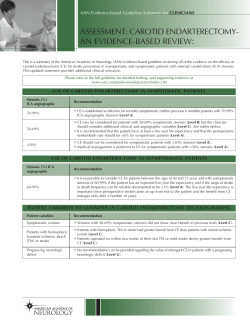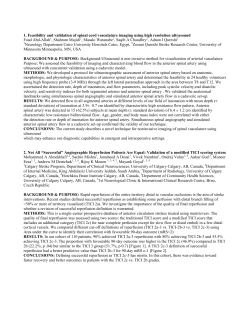
From IV thrombolytics and Beyond
From IV thrombolytics and Beyond Disclosure • None Dolora R. Wisco, MD Stroke Staff Cerebrovascular Center Cleveland Clinic Objectives • First line acute stroke therapy: IV tPA • Telestroke role in delivering IV tPA • Second line acute stroke therapy: endovascular stroke therapy Stroke is a major problem • Annual incidence ~795,000 strokes each year • 3rd leading cause of death • Leading cause of disability • Direct and indirect cost ~$73.7 billion per year • By 2030, an additional 4 million will have had stroke. • 24.9% increase in prevalence from 2010 What are the Types of Stroke? • Ischemic Stroke (Blockage) o Caused when there is a blockage in the blood vessels to the brain • Hemorrhagic Stroke (Bleeding) o Caused by burst or leaking blood vessels in the brain Stroke Mechanism: • Ischemic (87%) TOAST classification: • Large-artery atherosclerosis (thrombosis and artery-toartery embolism) • Cardioembolism (Afib, left ventricle thrombus, etc) • Small artery occlusion (lacune/lipohyalinosis) • Stroke of other determined cause (dissection, infective endocarditis, vasculitis etc) • Stroke of undetermined cause (a.k.a. cryptogenic) • Hemorrhagic (13%): • Intraparenchymal hemorrhage (10%) • Subarachnoid Hemorrhage (3%), SAH Time is Brain! Neurons Lost Synapses Lost Accelerated Aging Per Stroke 1.2 billion 8.3 trillion 36 yrs Per Hour 120 million 830 billion 3.6 yrs Per Minute 1.9 million 14 billion 3.1 weeks Per Second 32,000 230 million 8.7 hrs (Total number of neurons in the average human brain is 130 billion) Penumbra concept • There is tissue is ischemic but not infarcted—”Tissue at risk” around a “core” o Blood flow dependence o Time dependence Stroke. 2004;35[suppl I]:2662-2665 Donnan et al, Lancet Neurol 2009 Stroke 2006;37:263-266 Time is Brain! Normal blood flow 50ml/min/100grams brain tissue Ischemia: 0-4 min (blood flow <20ml/min/100grams brain tissue) Infarction = irreversible cell death: >10 min (blood flow <10ml/min/100g) Penumbra: area at risk surrounding infarct In the CNS, the areas served by the major vessels are also served by collateral circulation; therefore, the areas of infarction and penumbra vary patient-to-patient and the timing of infarction may likewise vary. Acute stroke treatment goal is to save the penumbral area and minimize the size of the infracted brain. SUDDEN ONSET … Stroke symptoms... UNILATERAL: -Loss of vision - Visual field cut -Weakness -Numbness -Tingling -Aphasia -Facial droop -Loss of balance -Slurred speech -Difficulty swallowing -Double vision -Sudden coma Time of Onset or Last Know Well Stroke Assessment • If witnessed symptom onset: Time of onset • If not witnessed symptom onset: Last seen at baseline health/function • Woke up with symptoms: Last seen at baseline – usually when pt went to bed, or in middle of night if patient witnessed to be normal • Times of reference • ABC • Finger stick for blood glucose – hypoglycemia symptoms can mimic stroke • Get Vitals • Focused history o Television o The time the basketball game started o Recent events – stroke, MI, trauma, surgery, bleeding o List of patient meds o Look specifically for anticoagulants (warfarin, apixiban, pradaxa, rivaroxiban, etc) , antiplatelet (aspirin, Plavix, Aggrenox) , insulin and antihypertensive use • Comorbid conditions – HTN, DM, AFib - Neurological examination … NIHSS Acute Stroke Treatment Options • Time Dependent • Acute stroke thrombolysis treatment windows: o IV thrombolysis with IV tPA • < 3 hrs (IV t-PA) Æ and up to 4.5 hours in some instances o Endovascular Therapy • 6 hrs (IA thrombolytics) • < 8hrs (Mechanical thrombolysis) • >?hrs (Basilar occlusion) IV Tissue Plasminogen Activator NINDS TPA & ECASS 3 Results • Alteplase o Recombinant tissue plasminogen activator (rt-PA) o Only FDA approved treatment for acute ischemic stroke in 0-3 hour time window o Not FDA approved for 3-4.5 hour time window. However, this is recommended by AHA/ASA NINDS TPA Trial 0-3 hours 13% ECASS 3 Trial 3-4.5 hours IV tPA for cerebral ischemia within 3 hours of onset changes in outcome due to treatment UCLA 7.3% We also give tPA to non‐strokes • In a retrospective study of tPA treated patients o 12.5% of patients have no stroke on MRI • 9% classified as TIA, 3.5% as non strokes • Others report 3-14% • Complications risk is low Winkler et al, Stroke, 2009 Savitz et al, Neurology, 2010 Uchino et al, Cerebrovasc Dis, 2010 Barriers to IV tPA use • Lack of recognition of stroke by patient/ family • Lack of recognition of stroke by EMS, triage personnel • Lack of immediate notification of stroke team • Lack of stroke team/ organized acute treatment protocol • Delays in imaging/ lack of 24-hour CT scanning • Fear of IV t-PA by non-neuroloigst or non-stroke trained physicians Telestroke • Video conferencing technology offers us the opportunity to assess patients outside of PSCs, with the potential to offer more patients acute IV tPA therapy LIMITATIONS OF IV TPA Telestroke • STARR registry (Arizona) o 25% of patients received IV thrombolysis • 6% hemorrhage rate o Majority of patients were managed in the Spoke hospital (64%) • Telestroke vs telephone • Recanalization rate poor for larger arteries such as ICA or proximal MCA • Outcomes for persistent MCA occlusions poor • Limited time window o STRokE DOC: expert committee blinded to modality used o Telestroke consult resulted in more accurate decision making (98% vs. 82%) 40% 40% 35% 30% 25% 35% 31% 24% 20% 15% 10% 5% 0% 8% All ICA MCA Stem MCA Divsn MCA Branch Del Zoppo et al., Ann Neurol 1993 Beyond IV thrombolytics o Patients with inelegible for IV tPA due to time window with severe stroke and a large vessel occlusion. o Patients who received IV tPA who have persistent large vessel occlusion and a severe stroke. o Endovascular Therapy • 6 hrs (IA thrombolytics) • < 8hrs (Mechanical thrombolysis) • >?hrs (Basilar occlusion) Endovascular Therapy for Acute Ischemic Stroke • Advantages o o o o Maximum delivery of lytic agent Endpoint of clot lysis Not given if spontaneous clot lysis Availability of mechanical methods • Disadvantages o o o o Transfer to center with interventional capabilities Time necessary to place catheter Requires interventionalists Emergent availability of angiography Intra‐arterial Thrombolytics 40% • • • • • • • 25% PROACT II Randomized multicenter controlled trial o 9 mg IA r-proUK + IV heparin vs. IV heparin alone Randomized 2:1 to treatment vs. control 180 pts with M1 or M2 occlusion by angio Treatment started within 6 hours of stroke onset IA r-proUK infused over 2 hours then repeat angio Primary endpoint - mRS ≤ 2 at 90 days Intra‐arterial Thrombolytics • IMS II • 81 subjects , NIHSS >10, received IV tPA w/in 3 hours of onset • Pts with arterial occlusion on angio received additional IA tPA • Feasibility and safety study P=0.04 Furlan et al, JAMA 1999 Mechanical thrombectomy o Allows further treatment of patient with large vessel occlusion • Stents/angioplasty • Mechanical thrombolysis o Trevo, Solitaire, Penumbra, Merci • Multi-modal (chemical + mechanical o Allows treatment of an expanded patient population (larger time window, postoperative patients) Solitaire Trevo Merci pull Merci Penumbra Mechanical Thrombectomy Post Merci single pull Penumbra Figure. A, Basal agiogram with occlusion of middle cerebral artery. Castaño C et al. Stroke. 2010;41:1836-1840 Copyright © American Heart Association, Inc. All rights reserved. IMS III • • • Stopped prematurely because of futility 656 participants Patients who had received intravenous t-PA within 3 hours after symptom onset were randomized 2:1 to: o IV tPA + IA therapy o IV t-PA alone Conclusion No significant difference in functional independence with endovascular therapy after intravenous t-PA, as compared with intravenous t-PA alone No difference in safety The Importance of Recanalization Recanalization is strongly associated with improved function outcomes and reduced mortality. Acute Stro Stroke ke Eligible for A Tx Eligible for IIA Patient Selection Beyond IV tPA • Non-contrast CT is important to rapidly rule out hemorrhage and allow administration of IV tPA • Time is Brain! MRI Eligible IV tPA Candidate MRI MRI Ineligible IV tPA Ineligible Inel igible IV tPA Ineligible Ineligible or or Al ready Rec’ Already Rec’d d tPA IV tPA Candidate Candi date o Systems of care should be organized to minimize delays • Imaging beyond non-contrast CT is required CT/CTA CT/CTA CT/CTA/CTP CT/CTA/CTP CT/CTA CT/CTA IV tPA IV tPA as Indicated Indicated IV tPA tPA as Indicated Indicated CT/CTA/CTP o CTA / CTP / MRI-DWI / MRI-PWI LVO w/o Lg Lg Infarct Infarct No LVO LVO // Infarct L VO w/o Lg Inf arct No LVO g Infarct In farct L VO / LLg No L VO / Lg Infarct No VO / Lg Infarct No LLVO ACUTE MRI ACUTE MRI STOP ACUTE ACUTE MRI STOP STOP STOP STOP STOP LVO w/o w/o Lg Infarct L VO w/o LVO w/o Lg Infarct Inf arct IA Tx Tx IA Tx Lg Infarct STOP Lg Infarct STOP No Lg Infarct IA Tx IA Tx No Lg Lg Infarct IA TX LVO: ICA, Prox Prox MCA, MCA, Bas Bas Lg Infarct: >? Lg NIHSS>DWI ? PWI >? MCA, >70cm33, NIHSS>DWI PWI Hyperacute MRI Protocol CT & CTA (+ MR) • 84 y.o. female with known atrial fibrillation • NIHSS 16 • LKW 4 hours • Truncated MRI protocol: o o o o o DWI FLAIR PWI Post-gad Ax T1 No need for SWI, MRA, etc 10 min • Challenges: o o o o o Case example Scheduling (interruption of other studies) Time delay in traveling to and from MRI Technologist availability Safety screening Inherent “chaos” of brain attack pts Case Presentation • 66 y/o LH male who awoke with symptoms of leftsided weakness; LKN 9 PM the night before (wake up stroke) • Our assessment at ~ 10 AM reveals: o NIHSS = 11 o Head CT: hyperdense R MCA sign o CTA: occlusion of distal Right M1 Right M1 distal occlusion 24 hrs post‐procedure Case Presentation • Given the clinical – diffusion mismatch & DWI – PWI mismatch, patient RB taken to interventional angiography • Successful recanalization of Right distal M1 occlusion • Brain MRI 24 hrs post-procedure o Persistent restricted diffusion in Right MCA territory as seen on initial scan- No notable expansion of infarct o Resolution of previous perfusion deficit • At f/u visit (4 wks after ictus)- NIHSS = 3 Case • Improved immediately post procedure, by next day weakness resolved although expressive aphasia remained • At 1 month follow-up visit, patient had returned to normal with no aphasia detected (NIHSS = 0) Conclusion • IV tPA is first line of stroke therapy o Can be given quickly and easily o Telestroke improves delivery of IV tPA • Endovascular Stroke Therapy is a treatment option for selected patients o Large vessel occlusion o Severe exam o Tissue at risk present Acknowlegement • Dr. Uchino • Dr. Hussain Questions
© Copyright 2025





















